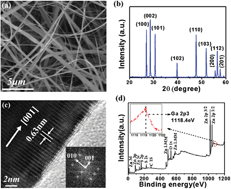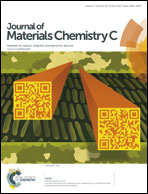Ultralow-voltage and high gain photoconductor based on ZnS:Ga nanoribbons for the detection of low-intensity ultraviolet light†
Abstract
A low-intensity ultraviolet photodetector (PD), with a gain as high as ∼2.4 × 106, has been successfully constructed based on gallium (Ga) doped zinc sulfide (ZnS) nanoribbons (NRs). The device exhibits excellent photoconductive properties upon a bias voltage as low as ∼0.01 V in terms of high sensitivity to UV light with an intensity of 1 μW cm−2 (corresponding to an incident power of 10−14 W), relatively fast response times of ∼3.2 ms, and an extremely high detectivity of ∼1.3 × 1019 cm Hz1/2 W−1. The high gain and fast response time are attributed to the excellent ohmic contact obtained by using a high quality ITO electrode and having a carrier mobility as high as 130 cm2 V−1 s−1, which was confirmed from the back-gate field effect transistors. These results show that the single-crystalline n-type ZnS:Ga NRs will have potential applications in future high-performance low-intensity ultraviolet photodetectors.


 Please wait while we load your content...
Please wait while we load your content...